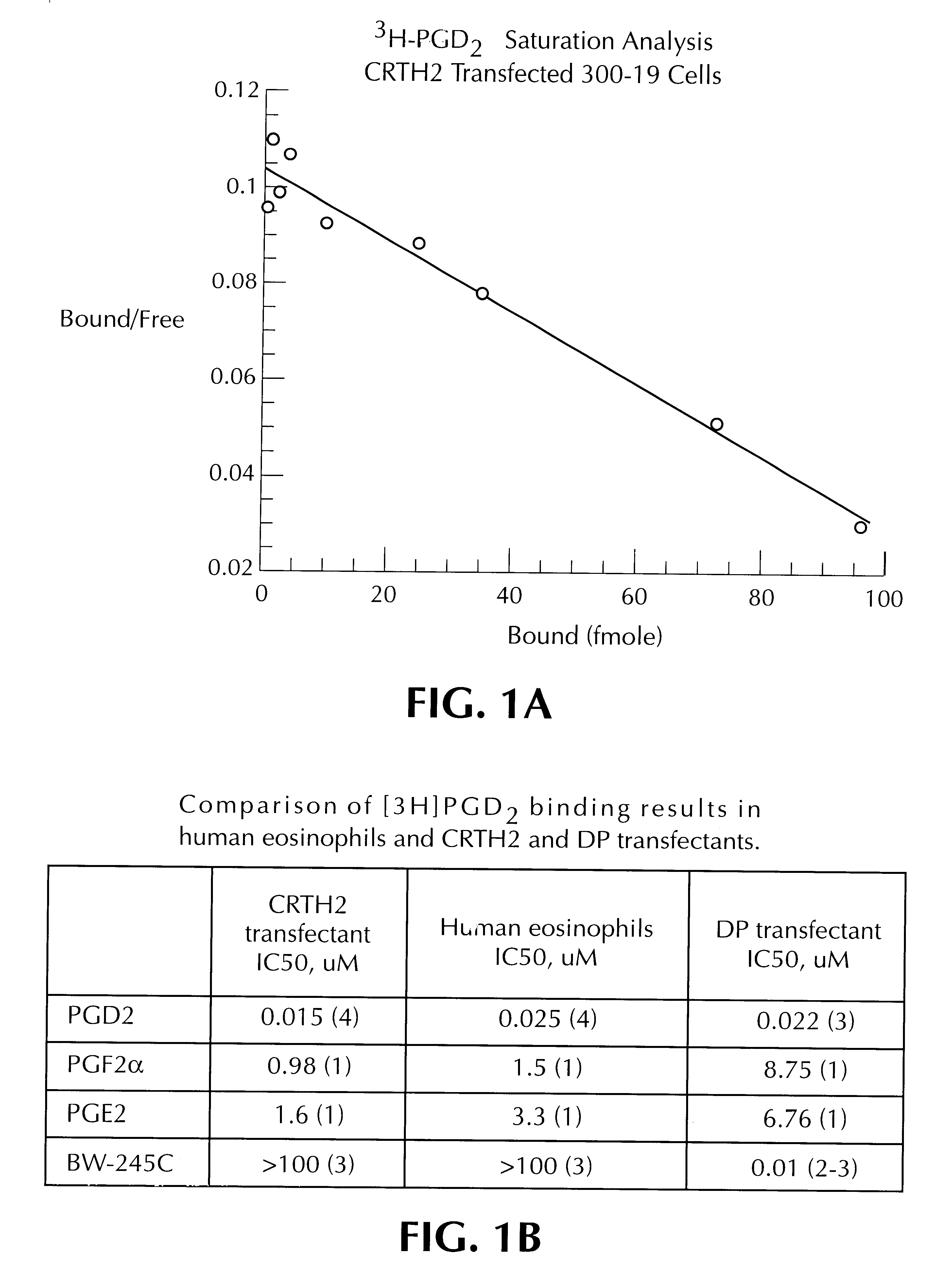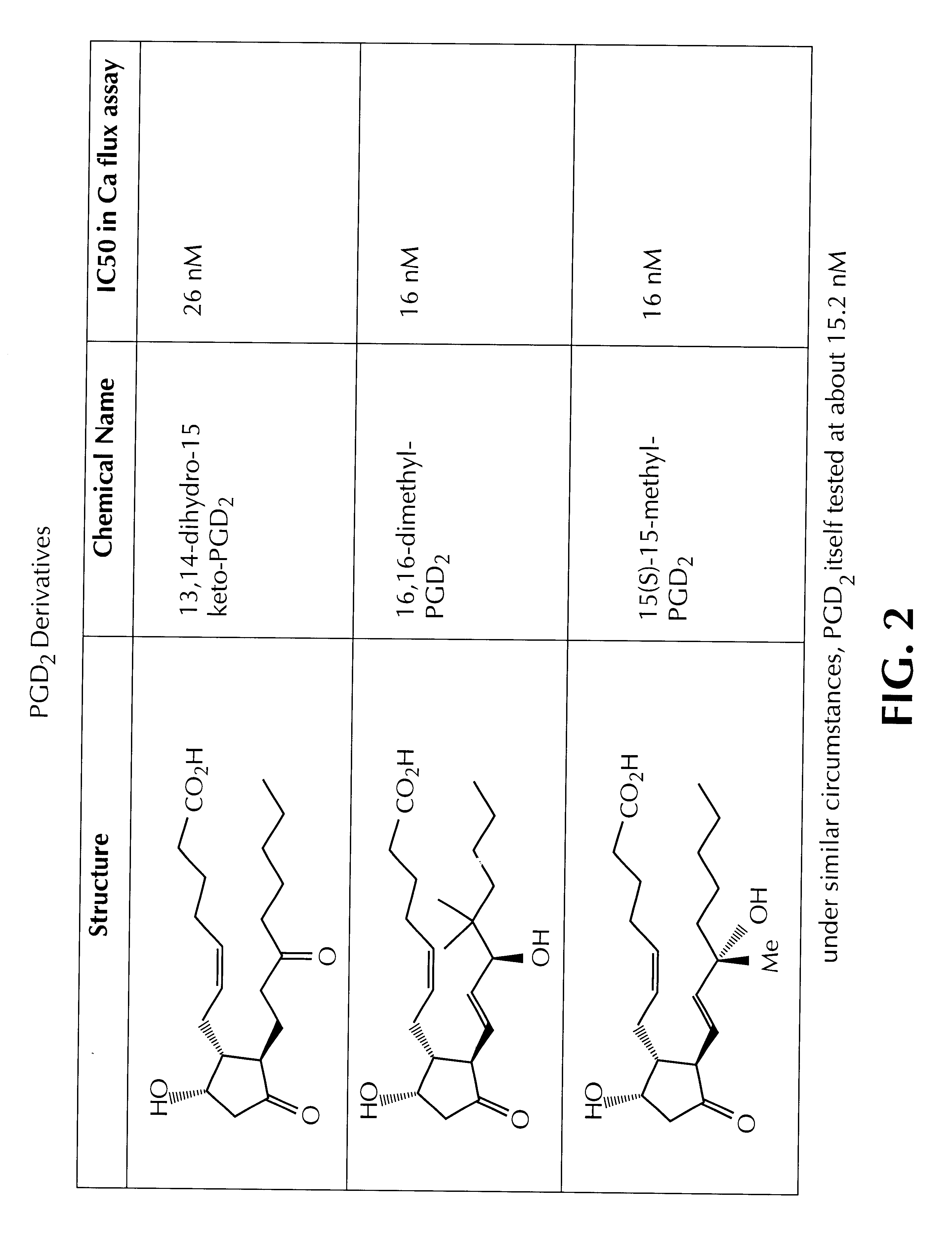Methods for the identification of compounds useful for the treatment of disease states mediated by prostaglandin D2
a technology of prostaglandin d2 and compound identification, applied in the field of compound identification, can solve the problems of limited use and low efficacy of these agents
- Summary
- Abstract
- Description
- Claims
- Application Information
AI Technical Summary
Benefits of technology
Problems solved by technology
Method used
Image
Examples
example 1
The in vivo and in vitro assays described in this Example characterize the PGD2 / CRTH2 interaction, identifying PGD2 as the key endogenous ligand for CRTH2.
Using 300-19 cells (transformed pre-B lymphocytes) expressing CRTH2, a number of mast cell and non-mast cell-derived mediators were screened in a [Ca2+]i mobilization assay. (300-19 cells are disclosed in M. G. Reth et al., Nature, 317(6035), pp. 353-365, 1985). For the experiments herein, CRTH2 was expressed from a plasmid “p3.1 prolacflag” which contains ampicillin and neomycin resisitance markers, and is driven by the CMV promoter. A prolac signalling peptide allows membrane expression of the gene insert, with a Flag peptide tag at the N terminal permitting convenient detection of the expressed molecule. A preferred level of expression of CRTH2 is about 40,000 molecules / cell surface.
Calcium flux studies demonstrated that PGD2 increased [Ca2+]i mobilization in a CRTH2 stable cell line with an EC50 of 15 nM. In contrast, PGJ2 had...
example 2
The following experiments were performed to further characterize CRTH2, and to determine the role of CRTH2 in PGD2-mediated inflammatory responses.
CRTH2 is a member of the 7-transmembrane G protein-coupled class of receptors. As a G protein-coupled receptor, CRTH2 is coupled through G-proteins to cytoplasmic mediated events. Interestingly, pertusis toxin inhibited PGD2-mediated eosinophil chemotaxis, suggesting that CRTH2 probably links with Gi. Studies also indicated that CRTH2 uses calcium as the second messenger but not cAMP.
In humans, CRTH2 has a broad tissue distribution, it is expressed in the brain, thymus, muscle, spleen, skin and other tissues. It is thus possible that CRTH2 may have different effects in different tissues, activating a particular gene product or activity in one cell type, and downregulating the same or another gene product or activity in another tissue, depending on the signal transduction pathway activated in that particular cell type.
Given topically to gu...
example 3
FIG. 2 presents results of the calcium flux assay (again using 300-19 CRTH2 transfectants) for close analogs of PGD2.
PUM
| Property | Measurement | Unit |
|---|---|---|
| volumes | aaaaa | aaaaa |
| volumes | aaaaa | aaaaa |
| temperature | aaaaa | aaaaa |
Abstract
Description
Claims
Application Information
 Login to View More
Login to View More - R&D
- Intellectual Property
- Life Sciences
- Materials
- Tech Scout
- Unparalleled Data Quality
- Higher Quality Content
- 60% Fewer Hallucinations
Browse by: Latest US Patents, China's latest patents, Technical Efficacy Thesaurus, Application Domain, Technology Topic, Popular Technical Reports.
© 2025 PatSnap. All rights reserved.Legal|Privacy policy|Modern Slavery Act Transparency Statement|Sitemap|About US| Contact US: help@patsnap.com



